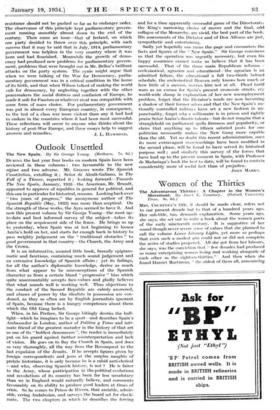Women of the Thirties
The Adventuroui Thirties : A Chapter In the Women's
MRS. COURTNEY'S title, it should be made clear, refers not to our present decade but to that of a hundred years ago. Her sub-title, too, demands explanation. Some years ago, she says, she set out to write a book about the women poets of the early nineteenth century. It is suggestive of her sound though never severe sense of values that she planned to call the volume Lesser Literary Lights, yet more so perhaps that even such a.modest aim could not or did not complete the series of studies projected. All she got from her labours, she says, was the conviction that " few decades had produced so many enterprising women living and working alongside of each other as the eighteen-thirties." And then when she found Harriet Martineau, " the ablest of them all, announcing that the best advocates of women's -rights would be the suc- cessful professional women and the ' substantially successful authoresses'," she felt that here, "put into a nutshell," was the real truth about the women's movement and the clue to the proper writing of its history—as biography. What was really needed was not an account of " parliamentary hap- penings and political manoeuvres," but one simply of feminine achievement through the ages, from Boadicea—or even earlier pioneers—onward. Not for her the full task, she modestly felt, but at least she might " write just one chapter of it " in a series of portraits of some sixteen women—" the most remarkable of a remarkable decade "—living and working in their various spheres as travellers, philanthropists, hostesses and " literary ladies."
Quite admirably, within her own easy limits, has she done so. On her very first page she disavows any claim to originality in the portraits themselves, or rather in the matter of the portraits. But her bright and lively pen gives fresh- ness to old material, and her selection and arrangement is in the main individually her own. Some of her subjects may seem rather to overlap her chosen period, as Angela Burdett- Coutts, who actually did not die until 1906, and Lady Emmeline Stuart-Wortley, who did not make the journey which sets her among the travellers and critics of America until 1849, but she might establish a case for both as inspired by that pre- Victorian impulse towards feminine independence which, with the Queen's ascent to the Throne and still more after her marriage to the Prince Consort, died or perhaps only slum- bered in all but a few brave spirits. On the other hand, much of the work of Mrs. Hemans was done before the opening of the decade, and she died in 1835 ; so was that of Maria Jewsbury, who died two years earlier, but in any case she is exceptional in receiving scarcely more than a page of atten- tion, so that one wonders why she was included at all. But the unfortunate " L. E. L.," whose mysterious death in Africa remains the most interesting thing about her, and the, in their various ways, hardly less unfortunate Caroline Southey and Caroline Norton are well enough in the picture.
The travellers, subdivided as " Voyagers to India " and " Critics of America," are an attractive group, including as they do " Mrs. Colonel Elwood," " the first and only female who has hitherto ventured overland from England to India " (and strange adventures she had on the way), the versatile and hard-working journalist Emma Roberts, and the better known Emily Eden and Harriet Martineau. The latter makes another appearance with Elizabeth Fry and Miss Burdett- Coutts among the Philanthropists, and here, as with the hostesses of the salons—Lady Holland, Lady Blessington . (upon whose relationship to D'Orsay Mrs. Courtney perhaps wisely refuses to pronounce) and Carlyle's Lady Ashburton— the reader is likely to find himself on more familiar ground. Mrs. Courtney, however, draws even these portraits with the ease and spontaneity of a real personal interest.
A century ago, she says, it looked as though " women must march straight on to triumphant equality." They were com- peting with men as writers and journalists, working beside them as reformers, defying conventions with tolerable impu- nity. Then came Victorianism and set-back. Today, true enough, we see thousands of women workers for every one a
hundred years ago. And yet, Mrs. Courtney asks, " Will the women's movement of our day, after an equally sudden spring forward, suffer a similar set-back ? " It seems incredible, nevertheless we have the unhappy examples of both Italy. and Germany to prove that it is not impossible.
GEOFFREY WEST.









































 Previous page
Previous page